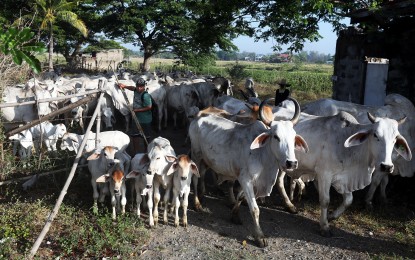
RABIES IN CATTLE. These cowherds guide cows in a newly rice harvest fields in Nueva Ecija in this March 24, 2022 photo. The Department of Agriculture (DA), confirmed three cases of rabies infection among cattle in Marinduque province on Tuesday (April 2, 2024). (PNA file photo by Oliver Marquez)
MANILA – The Department of Agriculture (DA) allayed fears over reported cases of rabies among cattle and pigs in Marinduque and Pampanga provinces.
In a phone interview, Agriculture Assistant Secretary Constante Dante Palabrica said although the reported cases may be a cause for concern, provincial veterinarians are closely monitoring the situation on the ground.
"Unusual lang kaya inireport ko ito (that's why I reported this), but it's not alarming. Ang importante ay ma-contain natin ang rabies sa (what's important is we contain rabies in) dogs and cats," he added.
According to the DA, recent reports in Marinduque include three cases of rabies among cattle and six cases of rabies among pigs; while around 20 cows in Pampanga were reported infected last 2023 due to rabid dog bites.
Palabrica, however, stressed that it doesn't happen naturally to animals.
"It's not true, it takes another rabid dog to transfer to another dog or cat, the virus. Alisin natin iyong pananaw na natural ito sa katawan ng Animalia (Let's eliminate the perception that it's naturally occurring in animals' bodies)," he said.
Remarkable symptoms after an animal bite include drooling, dizziness, and uneasy behavior for infected cows, while pigs tend to bump their heads and snouts.
Besides this, the DA also conducts stringent monitoring of the possible transmission of rabies to wildlife.
"We are still waiting for any report, ang mabigat kasi kapag wildlife naman ang kagatin ng aso (it's heavier if rabid dog bites wildlife animals), it might also spread into the wildlife," Palabrica said.
He also underscored the urgency to ensure vaccination among dogs and cats to avoid rabies transmission to animals and humans, which is highly fatal.
To date, the Department of Health already reported over 80 deaths due to rabies among humans from January to March this year.
Not for human consumption
Although there is no reported negative effect yet on individuals who ate one of the infected cows in Marinduque, Palabrica said that it would be better to avoid its consumption.
"Syempre pag-iingat na rin, alam nating zoonotic kasi ito, that can be transferred to the human being (Of course, just to be safe, we know this is zoonotic). We might as well not eat its meat," he said.
"Everything naman pinakukuluan before kainin ang baka at baboy (we're boiling beef and pork before we eat it), so the virus has less chance to survive because of the heat. But we do not encourage them, that's why we're very careful in NMIS (National Meat Inspection Service)," he added.
Palabrica said affected animals should be buried for disposal to prevent possible spread through consumption. (PNA)
